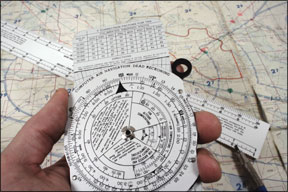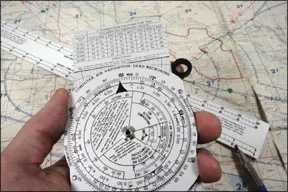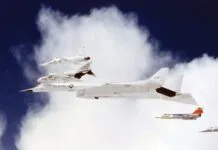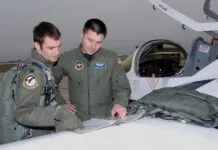Situational awareness, or “SA,” is sometimes used to explain why someone suffered an accident. “He had bad situational awareness” is supposed to describe a scenario in which a pilot does the unthinkable, and it results in tragedy. As with most Monday-morning quarterbacking, theres an element of “I would never do that” in applying the “bad situational awareness” label, a comforting thought for the next time we launch into the blue or descend into the murk. But knowing that the other pilot had “bad” SA does not ensure that somehow we will have “good” SA in similar

288
circumstances. After all, it is often highly experienced pilots, or even crews, who find themselves the subject of “bad SA” accident reports.
“SA” has many definitions, some very complicated. I propose a simple one: “The aircrews perception of the facts and conditions affecting the safe outcome of a flight.” Emphasis is on perception-mechanical glitches or human factors can alter the facts as observed by the pilot. The trick, then, is to detect when there may be a discrepancy between perception and reality, and take action to resolve that discrepancy before it becomes critical. Often, taking action involves a delaying action to allow time to sort things out.
Reviewing a large number of “bad SA” accident reports reveals common clues to a loss of situational awareness. Recognize one of these tip-offs and you may be able to better match your perceptions to reality.
Clue 1: Not meeting targets
Flying a non-precision instrument approach usually involves traveling though a series of altitude targets at prescribed distances from a reference point. A “poster child” accident involving apparent loss of situational awareness occurred on October 24, 2004, near Stuart, Va., and is detailed on page 9.
In this accident, the professional King Air crew obviously did not meet target altitudes at the proper time; in fact, the evidence suggests the crew was not precisely certain where they were on the approach. They acted as if they were mentally one or more fixes behind the procedure they were flying, not recognizing the missed approach point until they were eight miles beyond it. Failure to meet these targets might have resulted from feeling “rushed” to fly the procedure mere moments after being told to expect nearly half an hours wait in the hold.
Getting back their situational awareness may have been far easier had the crew not crossed the final approach fix inbound until they were at the initial altitude of 2600 feet. Just one turn in the hold would have given them plenty of time to descend. More importantly, that extra turn in the hold-and the five-plus minutes it would have required-may simply have given the crew more time to plan for the approach and reinforced precise positional awareness. If the crew discussed their position during the descent-there was no record of in-cockpit communications in the King Air-getting positional awareness back might have necessitated flying the missed approach procedure immediately to re-establish SA before again attempting the approach.
Clue #2: Feeling rushed
One of my earliest instructors imparted this wisdom: Beware the day you feel rushed getting into an airplane. A “hurry up” attitude creates many opportunities for lost situational awareness. Whether VFR or IFR, safe flight is best achieved by considering probable actions ahead of time, then adjusting those expectations as needed if conditions change. A trip planned literally “on the fly” requires greater focus on decisions that should have been made before taking off. This limits your ability to see the larger picture…it leads to “bad SA.”
The best tool for setting a proper pace in aviation is the checklist, and this is where you have the opportunity to retrieve your lost SA. In addition to providing steps in a logical order and ensuring that everything that needs to be done has been done, pulling out and reviewing checklists slows a frantic pace and reintroduces a methodical approach that might be lost in a rushed cockpit. It gives you time to heighten your SA by looking at indications and actions. The old timers had a saying that accomplishes the same thing-the first step in an emergency procedure was to “wind the instrument panel clock.” Maybe not taken literally, this sage advice does suggest that pilots take a moment to assess a situation before acting impulsively.
Clue #3: Lack of planning
Its been a few years, but I remember laying out Sectionals and, when IFR, en route charts on the floor to plan a long-distance flight. Then came computerized flight planning and much less prompting for this level of chart scrutiny. Point-to-point navigation with GPS systems makes it even easier to “jump in and fly.” The trend is toward minimalist flight planning, including taking copies of only those charts a pilot expects to need, and seemingly little evaluation of the en route phase between departure and the anticipated arrival airport.
A Baron recently impacted mountains east of Albuquerque (see page 11). The pilot may have reviewed relevant charts but, for some reason, did not climb to clear the ridge east of Albuquerque. It appears, however, his altitude may have been selected to overfly ABQs airspace without considering the mountains beyond.
If you find yourself aloft and uncertain of the minimum safe altitude for every segment of your flight, pull out the charts and find out now, or get on the ground and truly plan your flight. In todays GPS-direct world, theres still a need for finger-on-the-chart crosschecking, mainly to ensure off-airways minimum safe altitudes. Resist the temptation to minimize your flight planning so you dont find yourself nearing an unexpected obstacle, or if weather, mechanical or passenger issues require you to change routings or destinations.
Clue #4: Mission fixation
The opposite end of the spectrum from lack of planning is mission fixation-being so intent on meeting a preplanned goal that you ignore other possibilities, even in the face of a deadly hazard. Most fuel exhaustion accidents fit this mold-its uncanny how many airplanes run out of fuel within sight of the intended destination.
Attempted visual flight into instrument conditions-the most deadly mishap scenario in general aviation-can be a symptom of fixation on the goal to the exclusion of solid evidence that the attempt is unsafe. Ive written here about the human-factors hazards of attempting the same instrument approach more than once.
To retrieve your situational awareness from the grip of mission fixation, plan each flight, but also plan for alternatives, and take the safe way out when presented with adverse indications or conditions. If you find yourself without alternatives at any stage of a flight, you should instantly recognize your ability to manage the situation has been compromised. Return to “good SA” by gathering additional weather information, recomputing your fuel state and objectively looking at the safety of continuing as planned. Then review your alternatives and deviate if necessary to maintain an acceptable level of risk.
Clue #5: Ambiguity
Have you ever found yourself doing this?
Clearance delivery: “N12345, youre cleared to XYZ via (garbled) vectors direct Gabby, then as filed….”
Pilot: “345, repeat the first part of the routing please.”
Clearance delivery: “345, youre cleared (garbled) vectors direct Gabby then as filed.”
Pilot: “That was radar vectors to Gabby, then as filed?”
Clearance delivery: “(Garbled)”
Pilot: “Roger.”
I know Ive been tempted to leave it at that, hoping I had the gist of my route or that controllers would clear things up later on. And then immediately Ive forced myself to be a pain and ask Clearance Delivery to make it very clear exactly what they want me to do. Ive also asked ATC to spell the name of intersections or navaids they want me to use. Controllers may hate it, but wed all hate it more if my lack of understanding and frustration with the communications process led to a deviation…or worse.
Ambiguity also exists when you have contradictory data (example: Fuel gauges dont agree with takeoff fuel load and burn rate expectations) or if you are unable to meet your performance targets.
Confusion is the manifestation of bad situational awareness. If you have an ambiguity, or any confusion about your route, altitude, fuel state, systems capability or aircraft performance, “wind the clock” (i.e., pause to assess the situation) and determine what information you have seems accurate and which is bogus. Think of how an instrument pilot is taught to identify a failed instrument: Use two independent instruments that agree to overrule an errant third gauge. Look at all in-flight ambiguities this way-what is there about the status, or the fuel level indication, or the weather confirming your situation, and what is the bad information?
Clue #6: Bad feelings
Buried in each of the six Star Wars movies is a single line, uttered by a different character each time: “I have a bad feeling about this.” The statement almost always immediately precedes some life-threatening disaster. The Force may not be with you, but I bet there have been times when you just didnt feel right about something going on in the cockpit. A “bad feeling” tells you theres something about the status you dont like, but have not yet identified. Chances are youll find out soon enough if you dont do anything.
Trust that inner voice. A “bad feeling” means you have “bad SA.” Use the prompt to review checklists, weather, fuel state, altitudes and communications…all those things commonly resulting from bad situational awareness.
SA and TAA
Theres no question moving map displays in Technologically Advanced Aircraft (TAA) have the potential to dramatically improve SA. Advanced cockpits, however, have not proven to be a panacea for avoiding SA-linked accidents. According to the AOPA Air Safety Foundations Technologically Advanced Aircraft Special Report, transitioning to and flying the “mental airplane” means “coping with distractions from the additional information” itself. “There have been numerous Aviation Safety Reporting System (ASRS) reports of [pilot] confusion stemming from use of TAA or equipment that is typically installed in TAA.” ASRS reports include “missing assigned routes, mis-programming approaches, mode confusion [not knowing what the panel is displaying or doing, and] altitude busts because of distraction with the equipment.”
Instead of solving the problems of situational awareness, TAA introduces a whole new set of issues to overcome in order to see yourself as part of a much larger picture. “Pilots have always been susceptible to distraction,” AOPA concludes. Emphasis must be placed on pilot mastery of TAA systems and displays in addition to “stick and rudder” flying skills, and guarding against “over-reliance in their avionics and the aircraft, believing that the equipment will compensate fully for pilot shortcomings.” (The AOPA ASF TAA Special Report is available at (http://www.aopa.org/asf/publications/topics/).
The fix might seem to obviate the benefits of flying a TAA, but the results are greater than the sum:Regain the situational awareness you had before flying a TAA, then add to it the advantages of moving maps and other cockpit advances, by getting fully checked out in the technology. This will probably mean a lot more instruction than is typical for an aircraft checkout, and may involve a trip to an avionics specialty course or even simulator training to master the equipment. Then the trick is to remain current by flying the TAA frequently in the ATC system.
Lastly, dont give up on tracking your progress on paper charts and keeping a fuel log just because cockpit computers now do this work for you-TAAs have proven especially susceptible to pilot error on simple data entry and you never know when the airplanes electrical system or sunspot activity or GPS RAIM error may leave the panel blinded with you still in flight.
Good SA
How do you know if youve got “good” situational awareness? One clue that you have the big picture is to realize when you are the subject of a traffic call to another airplane. ATC is not required to point out traffic among IFR or radar-participating VFR airplanes-controllers just need to keep the radar blips separated. They will issue traffic advisories, however, as time permits because if one airplane reports having another in sight the controller can assign separation responsibility to pilots and move on to working other airplanes (controllers, by the nature of their job, must have very good SA). Its not unusual for ATC to point out traffic to the pilot of one airplane but not report to the other. Youve got good situational awareness if you hear an airplane receive a traffic advisory, determine that youre the “other” airplane and use that information to locate the traffic.
My proudest personal SA moment was en route to Florence, S.C., in a Baron. Over western South Carolina, I heard a Delta MD-80 check in on approach after departing the Greenville Spartanburg International Airport. The airliner was cleared to 8000 feet for “crossing traffic at 9000”-me-relegating the jet crew to a quick level-off and increase in workload while sucking torrential volumes of jet fuel at low altitude.
Looking down to my left I could see the MD ahead so I called Approach and reported the airliner in sight. “I can deviate left if you want to let the Delta climb,” I offered. Immediately ATC told the jet crew traffic had them in sight, and cleared them without restriction to the flight levels. I got a nice on-frequency “thank you” from the Delta captain. More importantly, I knew where I was in relation to other traffic, what effect my presence had on the other airplanes efficiency and workload, and how a very minor change on my part would resolve the potential conflict for all parties. On that day at least, I had “good SA.”
Bad situational awareness is an oft-cited buzzword to describe how an otherwise experienced pilot flies into tragedy. Its easy to explain away “bad SA,” thinking its something that wont happen to us. The reality is we are all susceptible to bad SA at times; the good news is there are several clues that our SA has degraded, prompting us to review basic actions to regain the big picture.




